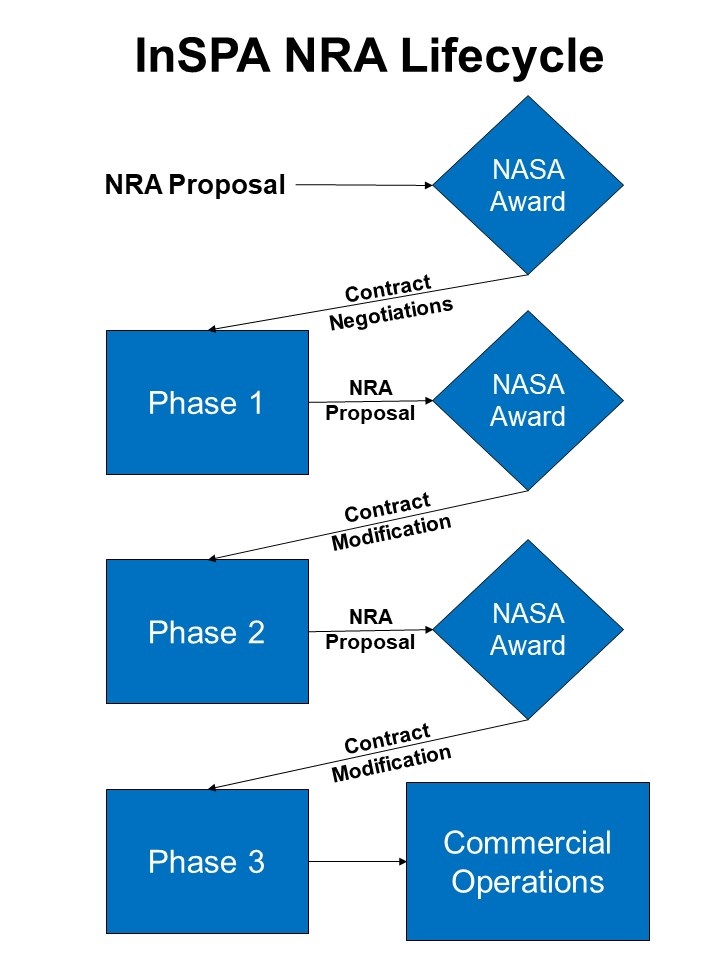NASA has awarded the Kennedy Operational and Institutional Support (KOIS) contract to Chiricahua-Logical Joint Venture of Albuquerque, New Mexico, to provide services at the agency’s Kennedy Space Center in Florida. KOIS is an Indefinite-Delivery Indefinite-Quantity, Level of Effort contract that includes a one-month phase-in period beginning Nov. 1, 2023, followed by a 22-month base period and three 1-year option periods. The maximum total award value is not to exceed $20 million. The scope includes a broad range of operational and institutional support services including internal controls for property, logistics, American…
Read MoreMonth: October 2023
InSPA Inter-Agency Collaboration Goals
High quality production photos of Robonaut (R2) in Building 14 EMI chamber and R1/EMU photos in Building 32 – Robonaut Lab. Photo Date: June 1, 2010. Location: Building 14 – EMI Chamber/Building 32 – Robonaut Lab. NASA / Robert Markowitz & Bill Stafford NASA knows it takes a village to make commercial manufacturing in space a reality. NASA is collaborating with experts from industry, academia and other U.S. Government agencies on the technologies in play with the InSPA portfolio. By joining forces with these experts, NASA can better support its…
Read MoreInternational Space Station astronauts show off creative outfits for Halloween
The International Space Station crew dressed up in Halloween costumes one day ahead of their next spacewalk. The four astronauts working in the U.S. segment posed, trick-or-treating style, with costumes in the Japanese Kibo module of the International Space Station on Wednesday (Oct. 31). Andreas Mogensen of the European Space Agency posted the costumes on X (formerly Twitter) and invited the audience to guess what the crew is wearing. Two of the astronauts, NASA’s Loral O’Hara and Jasmin Moghbeli, will then don very different outfits — spacesuits — on Thursday…
Read MoreNASA Implementation Strategy for In Space Production Applications
NASA’s In Space Production Applications (InSPA) implementation strategy consists of a multi-phase award process to demonstrate proof-of-concept, advance to high production quality, and ultimately to achieve scalability on a commercial low Earth orbit (LEO) destination or platform. InSPA seeks to identify awardees who propose promising manufacturing efforts in microgravity that will invigorate markets on Earth. These InSPA awards help the selected companies raise the technological readiness level of their products and move them to market, propelling U.S. industry toward the development of a sustainable, scalable, and profitable non-NASA demand for…
Read MoreIn Space Production: Applications Within Reach
In microgravity, crystals grow more slowly, but the molecules have time to align more perfectly on the surface of the crystal, which returns much better research outcomes. NASA After four decades of microgravity research, NASA and the ISS National Lab have identified numerous applications that are within reach for NASA’s In Space Production Applications (InSPA) portfolio. Uniform crystals, semiconductors, specialized glass and optical fibers are just a few of the many advanced materials that can benefit from production in microgravity. Artificial retinas, drug delivery medical devices, as well as the…
Read MoreChina’s Shenzhou 16 astronauts hand over Tiangong space station to new crew (video)
China’s space station has new occupants in charge. The departing Shenzhou 16 astronauts handed over control of the Tiangong space station to the newly arrived Shenzhou 17 crew during a short ceremony on Sunday (Oct. 29). “On behalf of the Shenzhou 16 crew, I formally and solemnly hand over [the key] to the commander of the Shenzhou 17 mission,” said Jing Haipeng, commander of the Shenzhou 16 mission. “I firmly believe, and all of us also believe, that under your leadership, your crew will cooperate closely, operate carefully, and complete…
Read MoreWhat is In Space Production Applications?
NASA supports In Space Production Applications (InSPA) awards to help the selected companies raise the technological readiness level of their products and move them to market, propelling U.S. industry toward the development of a sustainable, scalable, and profitable non-NASA demand for services and products in low-Earth orbit. These commercialization awards provide opportunities for NASA to reduce its future costs in LEO enabling deep-space missions farther from Earth, including the Moon and Mars. NASA is leading commercial LEO development efforts to stimulate non-NASA demand for commercially owned and operated orbital destinations from…
Read MoreNASA’s Lucy probe will fly by asteroid ‘Dinkinesh’ on Nov. 1. Here’s what to expect
NASA’s Lucy spacecraft is about to make its very first flyby of an asteroid on Wednesday, Nov. 1. When Lucy flies past the half-mile-wide asteroid, named Dinkinesh, the moment will mark the start of the probe’s 12-lear-long tour of 10 asteroid subjects. Ultimately, the planned legacy of this spacecraft is for it to become the first to investigate the Trojan asteroids — asteroids that follow Jupiter’s orbit around the sun and are believed to be remnants of our solar system’s formation. Lucy has been preparing for its visit to Dinkinesh…
Read MoreJust in Time for Halloween, NASA’s Juno Mission Spots Eerie “Face” on Jupiter
On Sept. 7, 2023, during its 54th close flyby of Jupiter, NASA’s Juno mission captured this view of an area in the giant planet’s far northern regions called Jet N7. The image shows turbulent clouds and storms along Jupiter’s terminator, the dividing line between the day and night sides of the planet. The low angle of sunlight highlights the complex topography of features in this region, which scientists have studied to better understand the processes playing out in Jupiter’s atmosphere.
Read MoreNew Japanese spacecraft aims to explore the mysterious moons of Mars
Mars itself is a world of puzzlement, particularly when it comes to whether or not the planet is the home of ancient or even present-day life. But put that aside for the moment. Even without the possible presence of life, the Red Planet is mysterious enough due to the fact that it’s circled by a couple of oddballs. Nobody knows for sure how the two moons of Mars, Phobos and Deimos, got where they are or what they are made of. But now an audacious, adventurous undertaking is being readied…
Read More




